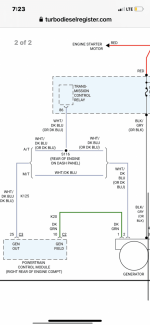Finally got the new steering box, rebuilt vacuum pump and new reman steering box and frame repair completed what a fiasco that was . Now the alternator isn’t charging . Pulled the alternator off and took it to Napa they put it on the machine it tests good for all that’s worth . Now I need to put it back on and check with my volt meter maybe the dash gauge is bad . Is the regulator in the pcm or ecm ? And if it’s bad how do I bypass it ?
-
TDR Magazine subscribers receive more than the magazine! You also gain additional forum privileges!
Details here: TDR Privileges
Subscribe to TDR Magazine here: https://www.tdr-online.com/
- Forums
- RAM: 2nd Generation (1994 - 1998) and .5 (1998.5 - 2002)
- 2nd Generation Ram Forum
- 2nd Generation Ram Forum Archive
You are using an out of date browser. It may not display this or other websites correctly.
You should upgrade or use an alternative browser.
You should upgrade or use an alternative browser.
Alternator not charging
- Thread starter SAndreasen
- Start Date
 Attention: TDR Forum Junkies
Attention: TDR Forum Junkies To the point: Click this link and check out the Front Page News story(ies) where we are tracking the introduction of the 2025 Ram HD trucks.
Thanks, TDR Staff
- Status
- Not open for further replies.
I have battery voltage at the blue wire on the back of the alternator but nothing on the green wire on the plug on the alternator. Hooked up my power probe with my volt meter hooked to the battery still not charging
Timd32
TDR MEMBER
Looked up the diagrams see attached.
The Battery Temp Sensor also plays a part in this. It under the drivers battery and needs to be functional. It's fairly easy to test... At room temperature of 25° C (75-80° F), an ohmmeter reading of 9,000 (9K) to 11,000 (11K) ohms should be observed. Just becareful and probe the sensor not the PCM side.
I would not try to just jump out the PCM, but someone else more familiar might know if that's a good idea, reads like it cycles the ground to the field based on system voltage and the battery sensor input.
Here are some words.........tried to crop them a bit to get the best answer.
Battery Temperature Sensor
SYSTEM OPERATION
The battery temperature sensor is used to determine the battery temperature and control battery charging rate. This temperature data, along with data from monitored line voltage, is used by the PCM to vary the battery charging rate. System voltage will be higher at colder temperatures and is gradually reduced at warmer temperatures.
1. The sensor is located under the battery and is attached (snapped into) the battery tray. On models equipped with a diesel engine (dual batteries), only one sensor is used. Location is under battery on drivers side of vehicle. A two-wire pigtail harness is attached directly to the sensor. The opposite end of this harness connects the sensor to the engine wiring harness.
2. Disconnect the two-wire pigtail harness from the engine harness.
3. Attach ohmmeter leads to the wire terminals of the pigtail harness.
4. At room temperature of 25° C (75-80° F), an ohmmeter reading of 9,000 (9K) to 11,000 (11K) ohms should be observed.
5. If reading is above or below the specification, replace the sensor.
6. Refer to the Replacement for procedures.
CHARGING SYSTEM VOLTAGE TOO LOW
NAME OF CODE
Charging System Voltage Too Low
WHEN MONITORED
With the ignition key on and the engine running over 1500 RPM after 25 seconds.
SET CONDITION
When the Powertrain Control Module (PCM) regulates the generator field and there are no detected field problems but the voltage output does not increase.
THEORY OF OPERATION
The PCM tries to maintain a system voltage between 12.9 volts and 15.0 volts. The voltage determined by the PCM as the final goal for the charging system is called "control" voltage. This control voltage is determined from the battery temp sensor (ambient sensor). The control voltage is compared to the sensed voltage continuously during running. The PCM controls battery voltage by energizing and de-energizing the alternator field winding. When the battery voltage falls below a setpoint voltage, the generator field winding is energized until the battery voltage exceeds a setpoint voltage.
POSSIBLE CAUSES
- Defects in generator drive belt or adjustment
- High resistance between battery (+) and generator (+)
- High resistance between battery (-) and generator ground
- PCM failure

CHARGING SYSTEM RESISTANCE TESTS
These tests will show the amount of voltage drop across the generator output wire, from the generator output (B+) terminal to the battery positive post. They will also show the amount of voltage drop from the ground (-) terminal on the generator to the battery negative post. Typical generator wiring harnesses are shown in. Wiring harness routing as shown may be slightly different depending on vehicle model and/or engine.
A voltmeter with a 0-18 volt DC scale should be used for these tests. By repositioning the voltmeter test leads, the point of high resistance (voltage drop) can easily be found.
Preparation
1. Before starting test, make sure battery is in good condition and is fully-charged. See Battery for more information.
2. Check condition of battery cables at battery. Clean if necessary.
3. Start the engine and allow it to reach normal operating temperature.
4. Shut engine off.
5. Connect an engine tachometer.
6. Fully engage the parking brake.
Test
1. Start engine.
2. Place heater blower in high position.
3. Turn on headlamps and place in high-beam position.
4. Turn vehicle interior lamps on.
5. Bring engine speed up to 2400 rpm and hold.
6. Testing (+) circuitry:
a. Touch the negative lead of voltmeter directly to battery positive post.
b. Touch the positive lead of voltmeter to the B+ output terminal stud on the generator (not the terminal mounting nut). Voltage should be no higher than 0.6 volts. If voltage is higher than 0.6 volts, touch test lead to terminal mounting stud nut and then to the wiring connector. If voltage is now below 0.6 volts, look for dirty, loose or poor connection at this point. Also check condition of the generator output wire-to-battery bullet connector (if equipped). Refer to Wiring for connector location. A voltage drop test may be performed at each (+) connection in this circuit to locate the excessive resistance.
7. Testing (-) circuitry:
a. Touch the negative lead of voltmeter directly to battery negative post.
b. Touch the positive lead of voltmeter to the ground terminal stud on the generator case (not the terminal mounting nut). Voltage should be no higher than 0.3 volts. If voltage is higher than 0.3 volts, touch test lead to terminal mounting stud nut and then to the wiring connector. If voltage is now below 0.3 volts, look for dirty, loose or poor connection at this point. A voltage drop test may be performed at each (-) connection in this circuit to locate the excessive resistance. This test can also be performed between the generator case and the engine. If test voltage is higher than 0.3 volts, check for corrosion at generator mounting points or loose generator mounting.
The Battery Temp Sensor also plays a part in this. It under the drivers battery and needs to be functional. It's fairly easy to test... At room temperature of 25° C (75-80° F), an ohmmeter reading of 9,000 (9K) to 11,000 (11K) ohms should be observed. Just becareful and probe the sensor not the PCM side.
I would not try to just jump out the PCM, but someone else more familiar might know if that's a good idea, reads like it cycles the ground to the field based on system voltage and the battery sensor input.
Here are some words.........tried to crop them a bit to get the best answer.
Battery Temperature Sensor
SYSTEM OPERATION
The battery temperature sensor is used to determine the battery temperature and control battery charging rate. This temperature data, along with data from monitored line voltage, is used by the PCM to vary the battery charging rate. System voltage will be higher at colder temperatures and is gradually reduced at warmer temperatures.
1. The sensor is located under the battery and is attached (snapped into) the battery tray. On models equipped with a diesel engine (dual batteries), only one sensor is used. Location is under battery on drivers side of vehicle. A two-wire pigtail harness is attached directly to the sensor. The opposite end of this harness connects the sensor to the engine wiring harness.
2. Disconnect the two-wire pigtail harness from the engine harness.
3. Attach ohmmeter leads to the wire terminals of the pigtail harness.
4. At room temperature of 25° C (75-80° F), an ohmmeter reading of 9,000 (9K) to 11,000 (11K) ohms should be observed.
5. If reading is above or below the specification, replace the sensor.
6. Refer to the Replacement for procedures.
CHARGING SYSTEM VOLTAGE TOO LOW
NAME OF CODE
Charging System Voltage Too Low
WHEN MONITORED
With the ignition key on and the engine running over 1500 RPM after 25 seconds.
SET CONDITION
When the Powertrain Control Module (PCM) regulates the generator field and there are no detected field problems but the voltage output does not increase.
THEORY OF OPERATION
The PCM tries to maintain a system voltage between 12.9 volts and 15.0 volts. The voltage determined by the PCM as the final goal for the charging system is called "control" voltage. This control voltage is determined from the battery temp sensor (ambient sensor). The control voltage is compared to the sensed voltage continuously during running. The PCM controls battery voltage by energizing and de-energizing the alternator field winding. When the battery voltage falls below a setpoint voltage, the generator field winding is energized until the battery voltage exceeds a setpoint voltage.
POSSIBLE CAUSES
- Defects in generator drive belt or adjustment
- High resistance between battery (+) and generator (+)
- High resistance between battery (-) and generator ground
- PCM failure
CHARGING SYSTEM RESISTANCE TESTS
These tests will show the amount of voltage drop across the generator output wire, from the generator output (B+) terminal to the battery positive post. They will also show the amount of voltage drop from the ground (-) terminal on the generator to the battery negative post. Typical generator wiring harnesses are shown in. Wiring harness routing as shown may be slightly different depending on vehicle model and/or engine.
A voltmeter with a 0-18 volt DC scale should be used for these tests. By repositioning the voltmeter test leads, the point of high resistance (voltage drop) can easily be found.
Preparation
1. Before starting test, make sure battery is in good condition and is fully-charged. See Battery for more information.
2. Check condition of battery cables at battery. Clean if necessary.
3. Start the engine and allow it to reach normal operating temperature.
4. Shut engine off.
5. Connect an engine tachometer.
6. Fully engage the parking brake.
Test
1. Start engine.
2. Place heater blower in high position.
3. Turn on headlamps and place in high-beam position.
4. Turn vehicle interior lamps on.
5. Bring engine speed up to 2400 rpm and hold.
6. Testing (+) circuitry:
a. Touch the negative lead of voltmeter directly to battery positive post.
b. Touch the positive lead of voltmeter to the B+ output terminal stud on the generator (not the terminal mounting nut). Voltage should be no higher than 0.6 volts. If voltage is higher than 0.6 volts, touch test lead to terminal mounting stud nut and then to the wiring connector. If voltage is now below 0.6 volts, look for dirty, loose or poor connection at this point. Also check condition of the generator output wire-to-battery bullet connector (if equipped). Refer to Wiring for connector location. A voltage drop test may be performed at each (+) connection in this circuit to locate the excessive resistance.
7. Testing (-) circuitry:
a. Touch the negative lead of voltmeter directly to battery negative post.
b. Touch the positive lead of voltmeter to the ground terminal stud on the generator case (not the terminal mounting nut). Voltage should be no higher than 0.3 volts. If voltage is higher than 0.3 volts, touch test lead to terminal mounting stud nut and then to the wiring connector. If voltage is now below 0.3 volts, look for dirty, loose or poor connection at this point. A voltage drop test may be performed at each (-) connection in this circuit to locate the excessive resistance. This test can also be performed between the generator case and the engine. If test voltage is higher than 0.3 volts, check for corrosion at generator mounting points or loose generator mounting.
Attachments
This is the 99 3500. I have a manual for my 98 but it will not open the 98 24 valve has a different plug on the alternator than a 99 does anyway . I supplied the green wire with a ground and power and still the alternator wouldn’t charge
So I have battery voltage on the blue whats the green wire ?
Timd32
TDR MEMBER
That 98 Diagram is a little different then the 99.
The 99 the + and - is driven off the PCM.
Take a look at this one. There looks to be a 3 wore and 4 wire generator as well. They note there are two.sheets and you will see the 4th wire off the diode pack.
That green is the field wire that is PCM controlled on both.
It still reads like it uses the engine speed, batt voltage, batt temp sensor.
But does not use that ASD relay circuit, its direct from the PCM.
Also it no longer has that voltage drop test I listed above.
The 99 the + and - is driven off the PCM.
Take a look at this one. There looks to be a 3 wore and 4 wire generator as well. They note there are two.sheets and you will see the 4th wire off the diode pack.
That green is the field wire that is PCM controlled on both.
It still reads like it uses the engine speed, batt voltage, batt temp sensor.
But does not use that ASD relay circuit, its direct from the PCM.
Also it no longer has that voltage drop test I listed above.
Attachments
Timd32
TDR MEMBER
Does not sound as simple as just grounding it.
When the DRB deal is used to test the Field Driver it pulses at a rate of 1.4s, according to this one.
When the DRB deal is used to test the Field Driver it pulses at a rate of 1.4s, according to this one.
Attachments
Maybe I’ll get lucky and the battery temperature sensor got unplugged when I was changing out the vacuum pump and powersteering pump out . I hear of people putting an external regulator on to fix these hopefully it won’t come to that . I’ll have to do more checking tomorrow in the daylight thanks for all the info
Timd32
TDR MEMBER
Yeah that's an easy one, I should pull the 99 wiring for that...... I would look this non-oe over carefully due to the such minor changes Wonder if they got it all covered?
You will need to PM me an email address if you want the OE drawings for the "Engine Controls" it's a 34 page document, and just barely too large to upload here.
Someone might have a real simple answer as well.
I have read tons of threads on this and even with all the manuals it's super specific on these transition years every year they made a lot of little tweaks for all sorts of reasons.
I also see alot of external regulators getting pulled back off and fixing the base stuff again due to other issues.
What did the frame repair involve, just wondering if you pulled any grounds off and are in need of rechecking basics like that.
You will need to PM me an email address if you want the OE drawings for the "Engine Controls" it's a 34 page document, and just barely too large to upload here.
Someone might have a real simple answer as well.
I have read tons of threads on this and even with all the manuals it's super specific on these transition years every year they made a lot of little tweaks for all sorts of reasons.
I also see alot of external regulators getting pulled back off and fixing the base stuff again due to other issues.
What did the frame repair involve, just wondering if you pulled any grounds off and are in need of rechecking basics like that.
Attachments
Checked it on the right one . Checked voltage on the alternator output as well right now it’s not charging
BoeingDiesel
TDR MEMBER
Don't forget the PCM. Mine went south a few years back so I wired in an external regulator.
I think this is the one your after.
https://www.moparpartswebstore.com/...8QUOfZ_3npeVOYk9VhgzSopAEWq2PN9QaAm7iEALw_wcB
No idea if this is something you could source locally. I've never blown one. Give the local parts houses the part # in the link, maybe get lucky. Or call a dealership.
https://www.moparpartswebstore.com/...8QUOfZ_3npeVOYk9VhgzSopAEWq2PN9QaAm7iEALw_wcB
No idea if this is something you could source locally. I've never blown one. Give the local parts houses the part # in the link, maybe get lucky. Or call a dealership.
- Status
- Not open for further replies.

Issue 128 – Digital Version
Digital Magazines
FREE!
TDR Test Drive - Digital Edition
Renew
Subscribe
Gift Subscriptions

Back Issues
Subscription Status
Address Change Form
Buyer's Guides
Ram Diagnostic Trouble Codes
The Perfect Collection
The Perfect Collection Vol. II
TSB Updates
Dodge/Cummins Historical Overview
Cameron Collection
What Makes Us Tick?
Product Showcase
Advertising

Turbo Diesel Register

Issue 128 – Digital Version
Digital Magazines
FREE!
TDR Test Drive - Digital Edition
Renew
Subscribe
Gift Subscriptions

Back Issues
Subscription Status
Address Change Form
Buyer's Guides
Ram Diagnostic Trouble Codes
The Perfect Collection
The Perfect Collection Vol. II
TSB Updates
Dodge/Cummins Historical Overview
Cameron Collection
What Makes Us Tick?
Product Showcase
Advertising







